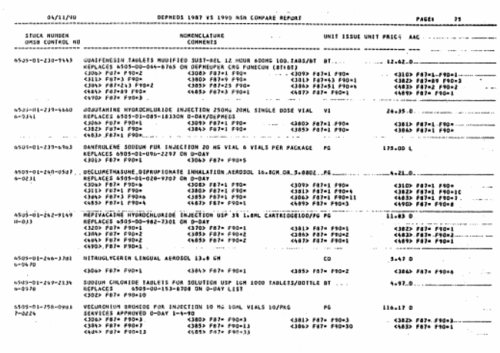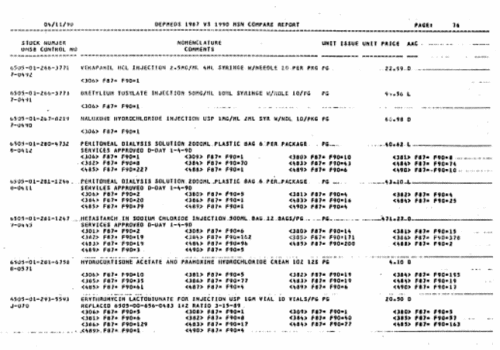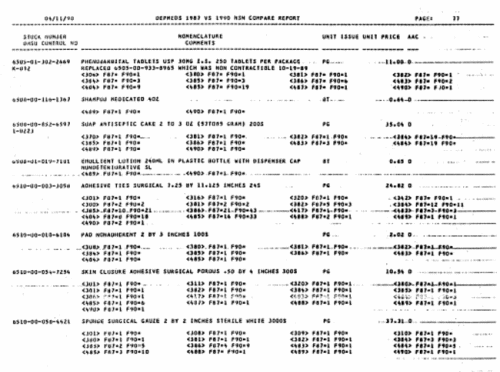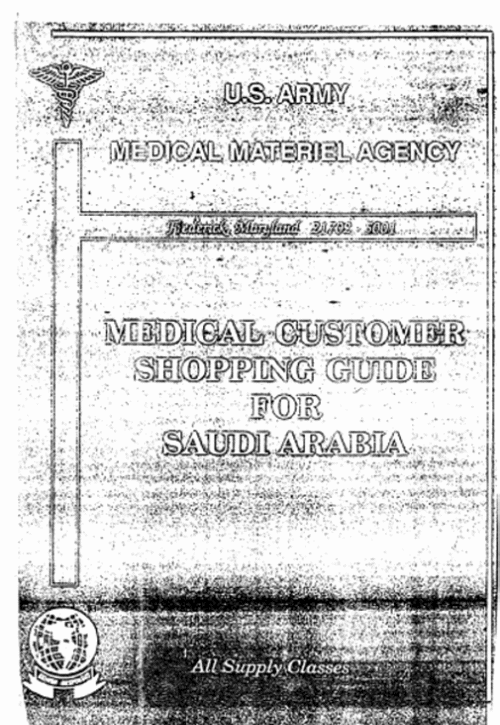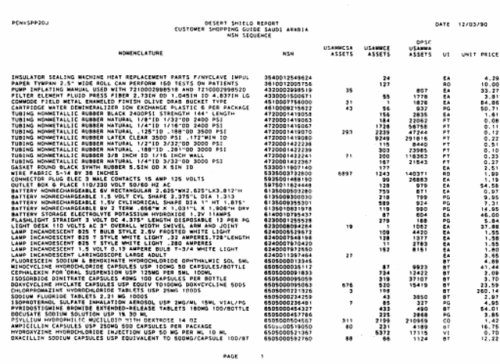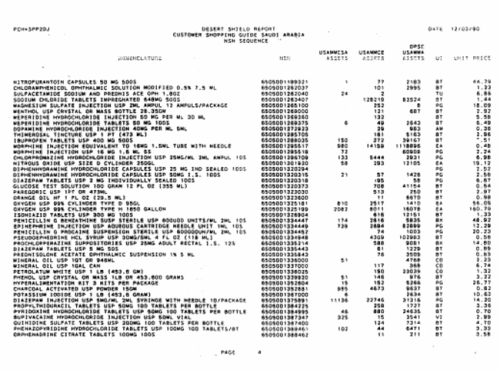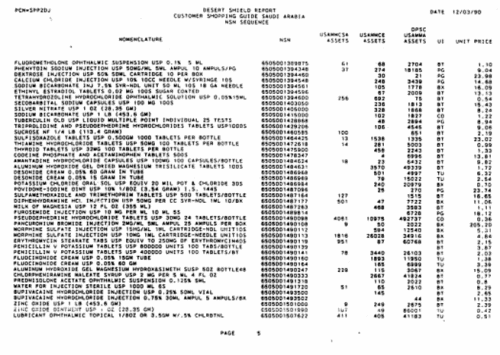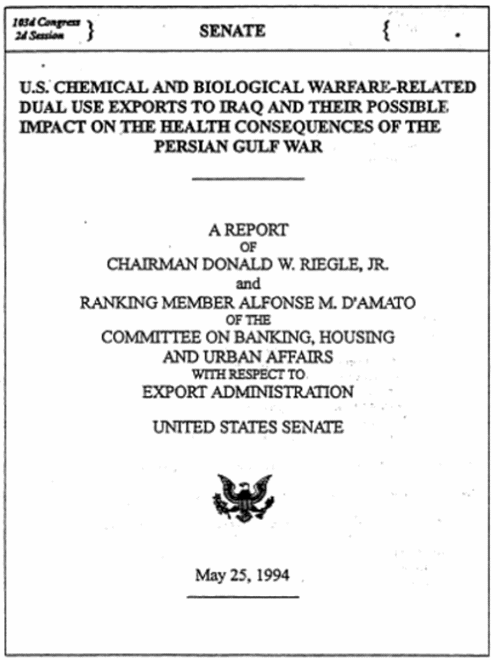Chapter 1, Part 2Vesicants and Blood AgentsLewisite - A vesicant toxic agent, industrial lewisite is a dark brown liquid with a strong smell. Lewisite is a contact poison with practically no period of latent effect. Lewisite vapors cause irritation to the eyes and upper respiratory tract. [42] According to the Center for Disease Control, lewisite would cause stinging and burning. Its smell, generally characterized as the strong smell of geraniums, could be confused with the smell of ammonia (the reaction to which is regulated by pain fibers rather than smell). [43] Iraqi stores of lewisite were not located after the war according to the Department of Defense.
Cyanogen Chloride - The French first suggested the use of cyanogen chloride as a toxic agent. U.S. analysts have reported that it is capable of penetrating gas mask filters. Partially soluble in water, it dissolves well in organic solvents. It is absorbed easily into porous materials; its military state is a gas. Cyanogen chloride is a quick acting toxic agent. Upon contact with the eyes or respiratory organs, it injures immediately. Lethal exposures result in loss of consciousness, convulsions and paralysis. [44]
Hydrogen Cyanide - A colorless liquid smelling of bitter almonds, hydrogen cyanide is a very strong, quick acting poison. Hydrogen cyanide affects unprotected humans through the respiratory organs and during the ingestion of contaminated food and water. It inhibits the enzymes which regulate the intra-cell oxidant-restorative process. As a result, the cells of the nervous system, especially those affecting breathing -- are injured, which in turn leads to quick death. An important feature of hydrogen cyanide is the absence of a period of latent effect. The military state of hydrogen cyanide is a gas. The toxic and physiologic properties of hydrogen cyanide permit it to be used effectively in munitions -- predominantly in rocket launched artillery. Death occurs after intoxication due to paralysis of the heart. Non-lethal doses do not cause intoxication. [45]
Blister AgentsAccording to the material safety data sheet (MSDS) for sulfur mustard gas (HD) prepared by the U.S. Army Chemical Research, Development and Engineering Center, Aberdeen Proving Ground, Maryland, "Chronic exposure to HD can cause skin sensitization, chronic lung impairment, cough, shortness of breath, chest pain, and cancer of the mouth, throat, respiratory tract, skin, and leukemia. It may also cause birth defects. (See appendix A for MSDS sheets on sulfur mustard agents HD and T.) The U.S. Army Chemical and Biological Defense Command lists the current detector sensitivity threshold for the M256A1 kits, a commonly used piece of chemical agent detection equipment in the Gulf War, as 2.0 mg/m3. [46] According to the Material Data Safety Sheets for sulfur mustard, total weight average exposures of greater than .003mg/m3 over an 8 hr. period requires the use of protective equipment. (See appendix A.) Therefore, the detection kit would not detect the agent until the amount of agent present exceeded the safety threshold by a factor of over 660. The M8A1 automatic alarms do not detect blister agent.
Mustard Gas - This is a colorless, oily liquid which dissolves poorly in water, but relatively well in organic solvents, petroleum, luricant products, and other toxic agents. The injurious effect of mustard gas is associated with its ability to inhibit many enzyme systems of the body. This, in turn, prevents the intra-cell exchange of chemicals and leads to necrosis of the tissue. Death is associated mainly with necrosis of the tissue of the central nervous system. Mustard gas has a period of latent effect (the first signs of injury appear after 2-12 hours), but does not act cumulatively. It does not have any known antidotes. In military use it can come in gas, aerosol, and droplet form. It therefore acts through inhalation, cutaneously, perorally and directly through the blood stream. The toxic and physico-chemical properties of mustard gas allow it to be used in all types of munitions. [47]
Related Chemical Agent InformationCommittee staff has learned that Iraq may have acquired any one of a number of the Soviet binary novachok ("newcomer") series of chemical warfare agent compounds or information relevant to the development of those compounds. This series of chemical warfare agents reportedly contains both lethal and debilitating agents. According to a confidential Committee source, if the Iraqis had obtained samples of these compounds they could be easily analyzed and produced with readily available materials. Several of these compounds are described as agents that even in microdoses can have long lasting effects. These agents are described as inducing myosis, vomiting, memory loss, involuntary motions and internal organ dysfunction. Many of these materials are also described as having mutagenic effects. These materials are, according to the source, stored in the lipids (body fats) and have no known antidotes. In addition, according to the Committee source, the Soviets were believed to have conducted research in a number of dioxin-based chemical warfare agents, and on at least one agent that could be used to contaminate drinking water supplies. Committee staff is conducting further inquiries to determine if Iraq may have had access to any of these compounds. [48]
BiotoxinsBiotoxins are natural poisons, chiefly of cellular structure. A distinction is made between exotoxins which are given off by an organism while it is alive, and endotoxins which are given off after a cell's death. The exotoxins cause the injurious effects of biological weapons, but endotoxins guarantee the effects of chemical weapons and do not cause the widespread disease outbreaks associated with biological warfare. Some examples of biotoxins include botulinus toxin and staphylococcic enterotoxin. [49]
Biological Warfare CapabilityAccording to the U.N., the Iraqi biological warfare program was initiated in mid- 1986 at Salman Pak. UNSCOM inspectors discovered evidence of research into certain biological agents including botulinus toxin and anthrax -- as well as organisms responsible for gas gangrene, tetanus and brucellosis, components of a biological weapons program which was not defensive in nature. In four years of work prior to the war, only 10 papers were published. These research programs focused on Iraqi efforts to isolate the most pathogenic spores. They also did research on the aerosolization and on the environmental survivability of some of these biological materials according to the United Nations. [50]
While the Department of Defense maintains that the Iraqi military did not weaponize its biological warfare program, UNSCOM is less certain, reporting that their degree of confidence that weaponization did not occur is low. In fact, readily high performance agricultural aerosol generators could easily be converted to both decontaminate areas in which chemicals are used and to aerosolize biological and chemical warfare agents.Other ways in which biological materials could have been weaponized include the use of Iraqi 250 and 500lb bombs, aerial rockets, unmanned aerial vehicles, FAW ground-to-ground missiles, helicopters and Iraqi aircraft. The Committee has received several reports of Iraqi helicopters penetrating Saudi airspace during the war by flying at low levels through the wadis and of Iraqi aircraft penetrating the area over the northern Persian Gulf.
According to UNSCOM, indications that suggested that the program was offensive in nature include:
• No declared links between the BW defense program and medical corps research.
• No links between aerosolization research and research on defensive filters.
The United Nations said that the Biological Inspection was initiated on August 8, 1991 at Salman Pak. The inspection was delayed because of the need to extensively immunize the members of the inspection team. The Salman Pak facility was razed one week prior to the arrival of the inspection team. [51]
The United States is aware of the Iraqi potential for using biological weapons. The employment of biological agents in a "cocktail" mix with chemical warfare agents is consistent with Soviet military doctrine. It is clear that biological weapons are much more difficult than chemical weapons to detect and defend against. Some of the symptoms experienced by veterans suffering from Persian Gulf Syndrome are consistent with biological warfare agent use. Verification will require sophisticated medical diagnosis, which to date has not been publicly undertaken.
The question of whether U.S. forces were attacked with a biological agent is problematic. According to Chemical/Biological Program: A Department of Defense Perspective, "it has been recognized that our biological defense program was inadequate. Creditble analysis indicated that optimal employment of biological agents could result in a significantly large hazard area." It further cites a memo from the Chairman of the Joint Chiefs of Staff to the SECDEF (Secretary of Defense) noting: "inadequate ability to counter BW (biological warfare) attack/BW defense is a priority requirement. [52]The inadequacy of the current biological defense and detection program was also supported by Deputy Secretary of Defense John Deutch in an unclassified May 6, 1994 address delivered at a Department of Defense sponsored counterproliferation conference at the Los Alamos National Laboratory. According to Deputy Secretary Deutch, the United States has "no biological detection capability deployed with any forces, anywhere."
Novel BW agents created by altering DNA plasmids and vectors are specifically intended to avoid detection. As noted below, several shipments of biological materials that might have been used to carry out such a program were licensed for export from the United States to the Iraq Atomic Energy Commission. In such a program, common intestinal flora such as e. coli could be altered to produce viral, bacterial, or other toxins and would be difficult to treat. If Iraq was successful in developing such agents, diagnosis will continue to elude physicians testing for traditional illnesses. Novel BW agents would certainly elude biological detection devices. There is evidence, based on the nature of the materials imported, that this type of research was being conducted. Since the Iraqi government managed to dismantle much of its biological warfare program prior to the UNSCOM inspections, we can only speculate on how advanced this program might have been. [53]
It has been suggested that if these problems the veterans are experiencing are Gulf War related, then we should be seeing even more serious problems among the Iraqis. Since beginning this investigation we have learned that many Iraqi enemy prisoners of war (EPW) suffered skin rashes, sores, nausea, vomiting, coughing and other medical problems while they were being detained in Saudi Arabia. Many members of units who had close contact with these individuals are now reporting to the Committee symptoms consistent with those being suffered by other Gulf War veterans. In addition, Iraq has claimed a dramatic rise in reported cases of communicable diseases since the end of the Gulf War including typhoid, brucellosis, hepatitis and cholera. [54]
Further, reports of Gulf War illnesses being reported are no longer limited to veterans of the Gulf War. Others reporting manifestation of these symptoms include:
• Department of Defense civilians who served in the Persian Gulf War.
• Department of Defense civilians working at the Anniston (AL) Army Depot and the Sharpsite (CA) Army Depot decontaminating equipment which was returned from the Persian Gulf.
• Spouses, particularly the spouses of male veterans, are reporting the following symptoms: chronic or recurring vaginal yeast infections, menstrual irregularities (excessive bleeding and severe cramping), rashes, fatigue, joint and muscle pain, and memory loss.
• Children born to veterans prior to the Gulf War. In many cases both male and female children born prior to the war have experienced symptoms similar to those of the veterans and their spouses.
• Children born following the Gulf war. Some reports have been published which suggest a high rate of miscarriages in the families of Gulf War veterans. Further, several reports have surfaced which suggest that there has been a high rate of physical abnormalities in children born to Gulf War veterans since the war.
U.S. Exports of Biological Materials to IraqThe Senate Committee on Banking, Housing, and Urban Affairs has oversight responsibility for the Export Administration Act. Pursuant to the Act, Committee staff contacted the U.S. Department of Commerce and requested information on the export of biological materials during the years prior to the Gulf War. After receiving this information, we contacted a principal supplier of these materials to determine what, if any, materials were exported to Iraq which might have contributed to an offensive or defensive biological warfare program. Records available from the supplier for the period from 1985 until the present show that during this time, pathogenic (meaning "disease producing"), toxigenic (meaning "poisonous"), and other biological research materials were exported to Iraq pursuant to application and licensing by the U.S. Department of Commerce. Records prior to 1985 were not available, according to the supplier. These exported biological materials were not attenuated or weakened and were capable of reproduction. According to the Department of Defense's own Report to Congress on the Conduct of the Persian Gulf War, released in April 1992: "By the time of the invasion of Kuwait, Iraq had developed biological weapons. It's advanced and aggressive biological warfare program was the most advanced in the Arab world... The program probably began late in the 1970's and concentrated on the development of two agents, botulinum toxin and anthrax bacteria... Large scale production of these agents began in 1989 at four facilities in Baghdad. Delivery means for biological agents ranged from simple aerial bombs and artillery rockets to surface-to-surface missiles." [55]
Included in the approved sales are the following biological materials (which have been considered by various nations for use in war), with their associated disease symptoms: [56]
Bacillus Anthracis: anthrax is a disease producing bacteria identified by the Department of Defense in The Conduct of the Persian Gulf War: Final Report to Contress, as being a major component in the Iraqi biological warfare program.
Anthrax is an often fatal infectious disease due to ingestion of spores. It begins abruptly with high fever, difficulty in breathing, and chest pain. The disease eventually results in septicemia (blood poisoning), and the mortality is high. Once septicemia is advanced, antibiotic therapy may prove useless, probably because the exotoxins remain, despite the death of the bacteria.
Clostridium Botulinum: A bacterial source of botulinum toxin, which causes vomiting, constipation, thirst, general weakness, headache, fever, dizziness, double vision, dilation of the pupils and paralysis of the muscles involving swallowing. It is often fatal.
Histoplasma Capsulatum: causes a disease superfically resembling tuberculosis that may cause pneumonia, enlargement of the liver and spleen, anemia, an influenza like illness and an acute inflammatory skin disease marked by tender red nodules, usually on the shins. Reactivated infection usually involves the lungs, the brain, spinal membranes, heart, peritoneum, and the adrenals.
Brucella Melitensis: a bacteria which can cause chronic fatique, loss of appetite, profuse sweating when at rest, pain in joints and muscles, insomnia, nausea, and damage to major organs.
Clostridium Perfringens: a highly toxic bateria which causes gas gangrene. The bacteria produce toxins that move along muscle bundles in the body killing cells and producing necrotic tissue that is then favorable for further growth of the bacteria itself. Eventually, these toxins and bacteria enter the bloodstream and cause a systemic illness.
In addition, several shipments of Escherichia Coli (E. Coli) and genetic materials, as well as human and bacterial DNA, were shipped directly to the Iraq Atomic Energy Commission.
The following is a detailed listing of biological materials, provided by the American Type Culture Collection, which were exported to agencies of the government of Iraq pursuant to the issueance of an export licensed by the U.S. Commerce Department: [57]
Date : February 8, 1985
Sent To : Iraq Atomic Energy Agency
Materials Shipped:
Ustilago nuda (Jensen) Rostrup
Date : February 22, 1985
Sent To : Ministry of Higher Education
Materials Shipped:
Histoplasma capsulatum var. farciminosum (ATCC 32136)
Class III pathogen
Date : July 11, 1985
Sent To : Middle and Near East Regional A
Material Shipped:
Histoplasma capsulatum var. farciminosum (ATCC 32136)
Class III pathogen
Date : May 2, 1986
Sent To : Ministry of Higher Education
Materials Shipped:
1. Bacillus Anthracis Cohn (ATCC 10)
Batch # 08-20-82 (2 each)
Class III pathogen
2. Bacillus Subtilis (Ehrenberg) Cohn (ATCC 82)
Batch # 06-20-84 (2 each)
3. Clostridium botulinum Type A (ATCC 3502)
Batch # 07-07-81 (3 each)
Class III pathogen
4. Clostridium perfringens (Weillon and Zuber) Hauduroy, et al (ATCC 3624)
Batch # 10-85SV (2 each)
5. Bacillus subtilis (ATCC 6051)
Batch # 12-06-84 (2 each)
6. Francisella tularensis var. tularensis Olsufiev (ATCC 6223)
Batch # 05-14-79 (2 each)
Avirulent, suitable for preparations of diagnotic antigens
7. Clostridium tetani (ATCC 9441)
Batch # 03-84 (3 each)
Highly toxigenic
8. Clostridium botulinum Type E (ATCC 9564)
Batch # 03-02-79 (2 each)
Class III pathogen
9. Clostridium tetani (ATCC 10779)
Batch # 04-24-84S (3 each)
10. Clostridium perfringens (ATCC 12916)
Batch #08-14-80 (2 each)
Agglutinating type 2
11. Clostridium perfringens (ATCC 13124)
Batch #07-84SV (3 each)
Type A, alpha-toxigenic, produces lecithinase C.J. Appl.
12. Bacillus Anthracis (ATCC 14185)
Batch #01-14-80 (3 each)
G.G. Wright (Fort Detrick)
V770-NP1-R. Bovine Anthrax
Class III pathogen
13. Bacillus Anthracis (ATCC 14578)
Batch #01-06-78 (2 each)
Class III pathogen
14. Bacillus megaterium (ATCC 14581)
Batch #04-18-85 (2 each)
15. Bacillus megaterium (ATCC 14945)
Batch #06-21-81 (2 each)
16. Clostridium botulinum Type E (ATCC 17855)
Batch # 06-21-71
Class III pathogen
17. Bacillus megaterium (ATCC 19213)
Batch #3-84 (2 each)
18. Clostridium botulinum Type A (ATCC 19397)
Batch # 08-18-81 (2 each)
Class III pathogen
19. Brucella abortus Biotype 3 (ATCC 23450)
Batch # 08-02-84 (3 each)
Class III pathogen
20. Brucella abortus Biotype 9 (ATCC 23455)
Batch # 02-05-68 (3 each)
Class III pathogen
21. Brucella melitensis Biotype 1 (ATCC 23456)
Batch # 03-08-78 (2 each)
Class III pathogen
22. Brucella melitensis Biotype 3 (ATCC 23458)
Batch # 01-29-68 (2 each)
Class III pathogen
23. Clostribium botulinum Type A (ATCC 25763)
Batch # 8-83 (2 each)
Class III pathogen
24. Clostridium botulinum Type F (ATCC 35415)
Batch # 02-02-84 (2 each)
Class III pathogen
Date : August 31, 1987
Sent To : State Company for Drug Industries
Materials Shipped:
1. Saccharomyces cerevesiae (ATCC 2601)
Batch # 08-28-08 (1 each)
2. Salmonella choleraesuis subsp. choleraesuis Serotype typhi (ATCC 6539)
Batch # 06-86S (1 each)
3. Bacillus subtillus (ATCC 6633)
Batch # 10-85 (2 each)
4. Klebsiella pneumoniae subsp. pneumoniae (ATCC 10031)
Batch # 08-13-80 (1 each)
5. Escherichia coli (ATCC 10536)
Batch # 04-09-80 (1 each)
6. Bacillus cereus (11778)
Batch #05-85SV (2 each)
7. Staphylococcus epidermidis (ATCC 12228)
Batch # 11-86s (1 each)
8. Bacillus pumilus (ATCC 14884)
Batch # 09-08-80 (2 each)
Date : July 11, 1988
Sent To : Iraq Atomic Energy Commission
Materials Shipped
1. Escherichia coli (ATCC 11303)
Batch # 04-875
Phase host
2. Cauliflower Mosaic Caulimovirus (ATCC 45031)
Batch # 06-14-85
Plant Virus
3. Plasmid in Agrobacterium Tumefaciens (ATCC 37349)
(Ti plasmid for co-cultivation with plant integration vectors in E. Coli)
Batch # 05-28-85
Date : April 26, 1988
Sent To: : Iraq Atomic Energy Commission
Materials Shipped:
1. Hulambda4x-8, clone: human hypoxanthine phosphoribosyltransferase
(HPRT) Chromosome(s): X q26.1 (ATCC 57236) Phage vector
Suggest host: E coli
2. Hulambda14-8, clone: human hypoxanthine phosphoribosyltransferase
(HPRT) Chromosome(s): X q26.1 (ATCC 57240) Phage vector
Suggested host: E coli
3. Hulambda15, clone: human hypoxanthine phosphoribosyltransferase
(HPRT) Chromosome(s): X q26.1 (ATCC 57242) Phage vector
Suggested host: E. coli
Date : August 31, 1987
Sent To : Iraq Atomic Energy Commission
Materials Shipped:
1. Escherichia coli (ATCC 23846)
Batch # 07-29-83 (1 each)
2. Escherichia coli (ATCC 33694)
Batch # 05-87 (1 each)
Date : September 29, 1988
Sent To : Ministry of Trade
Materials Shipped:
1. Bacillus anthracis (ATCC 240)
Batch # 05-14-63 (3 each)
Class III pathogen
2. Bacillus anthracis (ATCC 938)
Batch # 1963 (3 each)
Class III pathogen
3. Clostridium perfringens (ATCC 3629)
Batch # 10-23-85 (3 each)
4. Clostridium perfringens (ATCC 8009)
Batch # 03-30-84 (3 each)
5. Bacillus anthracis (ATCC 8705)
Batch # 06-27-62 (3 each)
Class III pathogen
6. Brucella abortus (ATCC 9014)
Batch # 05-11-66 (3 each)
Class III pathogen
7. Clostridium perfringens (ATCC 10388)
Batch # 06-01-73 (3 each)
8. Bacillus anthracis (ATCC 11966)
Batch #05-05-70 (3 each)
Class III pathogen
9. Clostridium botulinum Type A
Batch # 07-86 (3 each)
Class III pathogen
10. Bacillus cereus (ATCC 33018)
Batch # 04-83 (3 each)
11. Bacillus ceres (ATCC 33019)
Batch # 03-88 (3 each)
Date : January 31, 1989
Sent To : Iraq Atomic Energy Commission
Materials Shipped:
1. PHPT31, clone: human hypoxanthine phosphoribosyltransferase (HPRT)
Chromosome(s): X q26.1 (ATCC 57057)
2. Plambda500, clone: human hypoxanthine phosphoribosyltransferase
pseudogene (HPRT) Chromosome(s): 5 p14-p13 (ATCC 57212)
Date : January 17, 1989
Sent To : Iraq Atomic Energy Commission
Materials Shipped:
1. Hulambda4x-8, clone: human hypoxanthine phosphoribosyltransferase
(HPRT) Chromosomes(s): X q26.1 (ATCC 57237) Phage vector;
Suggested host: E. coli
2. Hulambda14, clone: human hypoxanthine phosphoribosyltransferase
(HPRT) Chromosome(s): X q26.1 (ATCC 57540), Cloned from human lymphoblast, Phase vector
Suggested host: E. coli
3. Hulambda15, clone: human hypoxanthine phosphoribosyltransferase
(HPRT) Chromosome(s): X q26.1 (ATCC 57241) Phage vector;
Suggested host: E. coli
Additionally, the Centers for Disease Control has compiled a listing of biological materials shipped to Iraq prior to the Gulf War. The listing covers the period from October 1, 1984 (when the CDC began keeping records) through October 13, 1993. The following materials with biological warfare significance were shipped to Iraq during this period. [58]
Date : November 28, 1989
Sent To : University of Basrah, College of
Science, Department of Biology
Materials Shipped:
1. Enterococcus faecalis
2. Enterococcus faecium
3. Enterococcus avium
4. Enterococcus raffinosus
5. Enteroccus gallinarium
6. Enterococcus durans
7. Enteroccus hirae
8. Streptococcus bovis
(etiologic)
Date : April 21, 1986
Sent To : Officers City Al-Muthanna,
Quartret 710, Street 13, Close 69, House 28/I,
Baghdad, Iraq
Materials Shipped:
1. 1 vial botulinum toxoid
(non-infectious)
Date : March 10, 1986
Sent To : Officers City Al-Muthanna,
Quartret 710, Street 13, Close 69 House 28/I,
Baghdad, Iraq
Materials Shipped:
1. 1 vial botulinum toxoid #A2
(non-infectious)
Date : June 25, 1985
Sent To : University of Baghdad, College of
Medicine, Department of Microbiology
Materials Shipped:
1. 3 years cultures
(etiologic)
Candida sp.
Date : May 21, 1985
Sent To : Basrah, Iraq
Materials Shipped:
1. Lyophilized arbovirus seed
(etiologic)
2. West Nile Fever Virus
Date : April 26, 1985
Sent To : Minister of Health, Ministry of
Health, Baghdad, Iraq
Materials Shipped:
1. 8 vials antigen and antisera (r. rickettsii and r. typhi) to diagnose rickettsial infections (non-infectious)
UNSCOM Biological Warfare InspectionsUNSCOM inspections uncovered evidence that the government of Iraq was conducting research on pathogen enhancement on the following biological warfare related materials: [59]
o bacillus anthracis
o clostridium botulinum
o clostridium perfringens
o brucella abortis
o brucella melentensis
o francisella tularensis
o clostridium tetani
In addition, the UNSCOM inspections revealed that biological warfare related stimulant research was being conducted on the following materials:
o bacillus subtillus
o bacillus ceres
o bacillus megatillus
UNSCOM reported to Committee staff that a biological warfare inspection (BW3) was conducted at the Iraq Atomic Energy Commission in 1993. This suggests that the Iraqi government may have been experimenting with the materials cited above (E. Coli and rDNA) in an effort to create genetically altered microorganisms (novel biological warfare agents).
________________
Notes: 42. Ibid, 205.
43. Interview with Dr. Sanford Leffingwell, Center for Disease Control on September 3, 1993.
44. Joachim Krause and Charles K Mallory, Chemical Weapons in Soviet Military Doctrine Military and Historical Experience. 1915-1991 . (Boulder, Co : Westview Press, 1992), 202, V. V. Miasnikov, Defense Against Weapons of Mass-Destruction: A Guide (Moscow: Voyenizdat, 1984, 82-83).
45. Joachim Krause and Charles K. Mallory, Chemical Weapons in Soviet Military Doctrine: Military and Historical Experience. 1915-1991. (Boulder, Co.: Westview Press, 1992), 205, V. V. Miasnikov, Defense Against Weapons of Mass-Destruction: A Guide (Moscow: Voyenizdat, 1984, 82, Vladimir K Pikalov, "Toxic Agents," The Soviet Military Encyclopedia. Volume 6 (Moscow: Voyenizdat, 1978).
46. This information was provided by the US Army Chemical and Biological Defense Command, Edgewood, Area, Aberdeen Proving Ground, Maryland 21010. According to the U.S. Army the sensitivity capacity for the M256A1 detector kit is:
Mustard / 2.0 / mg/m3
VX / 0.020 / mg/m3
G-Agents / 0.005 / mg/m3
The required response time for these levels is 15 minutes The capability and specifications of this unit are not classified.
47. Vladimir K Pikalov, "Toxic Agents," The Soviet Military Encyclopedia, Volume 6 (Moscow; Voyenizdat, 1978); Joachim Krause and Charles K. Mallory, Chemical Weapons in Soviet Military Doctrine: Military and Historical Experience. 1915-1991. (Boulder, Co.: Westview Press, 1992), 206-7.
48. Staff Interviews, April 19, 1994.
49. Joachim Krause and Charles K. Mallory, Chemical Weapons in Soviet Military Doctrine Military and Historical Experience. 1915-1991. (Boulder, Co.: Westview Press, 1992), 162, 209.
50. Staff interview, February 22, 1994.
51. Ibid.
52. Bill Richardson, John Carrico, Col. Frank J. Cox, LTC Jeffery Thomas, and Richard Sanders, Chemical/Biological Program: A Department of Defense Perspective. Office of the Assistant Secretary of Defense for Atomic Energy, presented as a paper to the Nuclear, Biological, and Chemical Symposium of the American Defense Preparedness Association, Camp Lejeune, North Carolina (May 12-14, 1993), 10.
53. Staff Interview, UNSCOM, February 22, 1994.
54. "Iraq Launches Drive to Combat Increasing Communicable Diseases," Xinhua News Agency (June 8, 1993), Item No: 0608002, "Iraq Faces Health Crisis," The Guardian (September 13, 1993), 7.
55. Department of Defense, Conduct of the Persian Gulf War: Final Report to Congress (April 1992).
56. Terry J. Gander, ed., Jane's NBC Protection Equipment 1991-92. (Surrey, U.K.: Jane's Information Group, 1992), 3-12: Dorland's Pocket Medical Dictionary, 24th Edition (Philadelphia W B Saunders Co , 1989), James A. F. Compton, Military Chemical and Biological Agents Chemical and Toxicological Properties (Caldwell, NJ The Telford Press, September 1987).
57. American Type Culture Collection, Rockville, Maryland (January 21, 1994).
58. Memorandum from Director of the Centers for Disease Control to Chairman Riegle.
59. Staff interview, UNSCOM, February 22, 1994.
